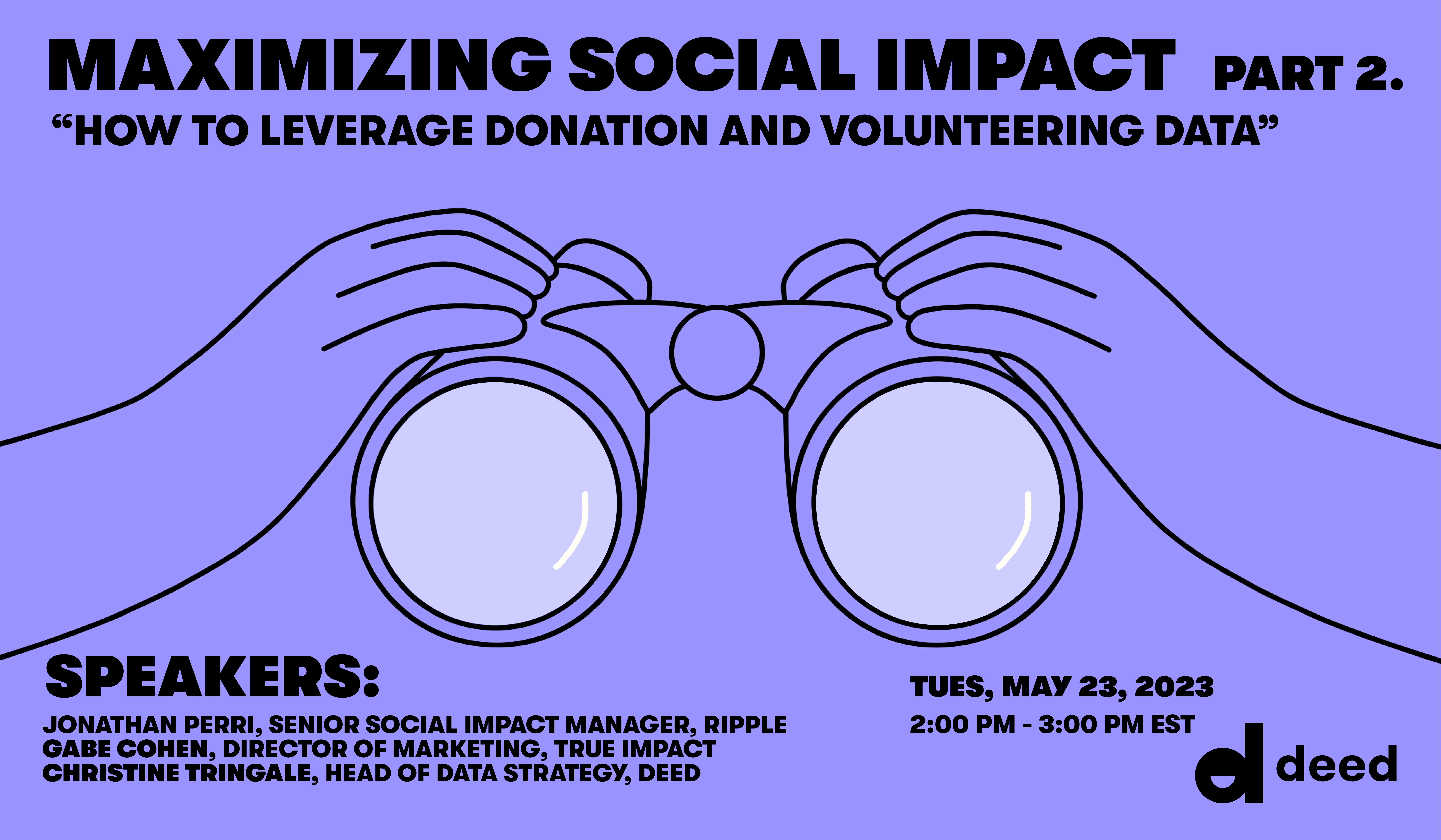4 Takeaways from “Maximizing Social Impact: Part 2”
Ripple, True Impact, and Deed sat down to discuss how to leverage employee volunteering and donation data.
Introduction
Social impact, corporate social responsibility (CSR), and environmental, social, and governance (ESG) teams need data to run well. Without it, our employees will feel like their contributions aren’t making a difference—and our communities won’t be able to see the good work our organizations are doing.
Our “Maximizing Social Impact” webinar series continues with “Part Two: How to Leverage Donation and Volunteering Data,” a close look at measuring employee engagement in social impact (including giving and volunteerism) as well as company matching. Gabe Cohen and Christine Tringale were joined by Jonathan Perri, Senior Social Impact Manager at Ripple, for another lively conversation on how to capture, interpret, and incorporate your data into an ever-greater social impact program.
Our panel shared their insight into some of the most important questions facing social impact practitioners today, including:
🧮 What data points are most important for social impact programs?
🧮 Now that I have my giving, volunteering, and engagement data, how should I interpret it?
🧮 What are proven strategies for incorporating the data into my team's decision-making process?
As you make your way through these three key takeaways from “Maximizing Social Impact Part 2: How to Leverage Donation and Volunteering Data,” don’t forget to grab your recording of the webinar to hear Jon, Gabe, and Christine’s thoughts, as well as questions from the audience.
Missed the first installment? Check out the key takeaways and watch the recording here.
4 Takeaways from “Maximizing Social Impact: Part 2”
1. Purpose-fit your social impact program to your organization’s core goals
There’s a lot of talk in the social impact space about aligning business goals with our organization’s more fundamental purpose. But what does that actually look like?
When social impact practitioners are deciding where to dedicate our limited resources, we may consider factors including: geography, demography, and cause area.
Say you work for a major multinational food company that cares deeply about curbing waste and ending hunger. If your nonprofit partner is active in a neighborhood that’s central to your business operations, then you’ve found geographic alignment. If their work would benefit the most underserved members of the local community in that neighborhood, you’ve found demographic alignment. And if you can demonstrate that your support for the nonprofit helped those people escape food insecurity, then you’ve found cause alignment.
It can be understandably difficult to find the right nonprofit partner serving the right people in the right place at the right time, and then to rally your own people to participate in the program. Finding alignment is a complex process with many moving parts, but your effort will be worthwhile.
2. Consider both internal and external social impact
From seemingly endless jargon to evolving environmental, social, and governance (ESG) reporting requirements, there are many parts of social impact work that can feel confusing to newcomers and veterans alike.
One important question that often goes unanswered because of that confusion is: Should our work benefit our own employees or the broader community. The answer? Both!
Not only does volunteerism, skill-sharing, and charitable giving boost employee morale and engagement, it also builds an authentic, mutually beneficial relationship between our people and the community. Over time, these relationships often blossom into deep passion for important causes that won’t just go away when the volunteer event is over.
One day at the food pantry may be a welcome break from the regular workday for our employees, but for the overworked nonprofit volunteers it will be a much-needed relief with a measurable positive outcome.
3. Be an empathetic partner to your nonprofit community
To get those big numbers we all want to share with our stakeholders that signify just how great an impact our organizations are able to make alongside our nonprofit partners, we have to work together on reporting. Don’t be shy to reach out to your nonprofit partners for a breakdown of where your dollars and volunteer hours are going—but remember to be considerate of their time and capacity.
Gabe Cohen from True Impact recommends measuring how much of the nonprofit’s time and effort you expect your reporting request to take against your organization’s overall contribution. That can include employee giving, employee volunteerism, corporate grants, pro-bono service, in-kind gifts, and board service. If you can assign a dollar amount to that total contribution, you’ll know how much effort you can reasonably ask for.
The size and scale will vary for every organization, but here’s a broadly applicable example of how to figure this out. If your total contribution amounts to $5,000 or less, do not ask the nonprofit for anything; let them focus on their missions and do what you can with their publicly available data and materials. But if you think the number is $10,000 or so, you might want to ask for a quick report on the outcomes or send a brief survey the nonprofit staff can answer in a few minutes. However, for significant contributions of $20,000 or more, go ahead and ask for a full report.
Remember: At the end of the day, what’s most important is to maintain a strong and empathetic working relationship with your nonprofit partners so that you can meet shared aims and make a great collective impact. Reporting is an important component of that effort, as it helps both organizations share an authentic, cohesive story, especially at a time when ESG is such a focal point of the national conversation.
4. Focus on cohesive social impact storytelling to rebuff anti-ESG backlash.
From Florida to Washington, D.C., the business community's effort to make the world a better place and the practical investing strategy that shows those efforts benefit everyone have somehow found their way into the center of the so-called culture war.
Similarly to how finding geographic, demographic, and cause area alignment will help boost the efficacy of your program, so too will authentic, cohesive social impact storytelling do a better job of convincing everyone inside and outside your organization that you’re truly committed to making a difference.
Fortunately, there is some indication that the ESG debate will blow over once we can prove our results. A new bipartisan study rises above the noise, showing how, from a legal perspective, “fiduciaries must maintain their duties of loyalty and prudence in making investment decisions, which take precedence over the political back and forth . . . and their war over words.”
Check out our social impact storytelling blog series for concrete advice on incorporating annual impact reports and giving and volunteering data into your year-round communications strategy.
Final thoughts
“Maximizing Social Impact” is a three-part webinar series from True Impact and Deed. We’re trying to lower the barrier for entry to meaningful impact measurement by breaking it down into achievable steps. Our hosts are Gabe Cohen, Director of Marketing at True Impact, and Christine Tringale, Head of Data Strategy at Deed.
If you missed the first installment, you can read the key takeaways and watch the recording here. Remember to keep an eye out for our announcement on the next installment later this summer. But if these first two editions have already given you ideas about how to better run your social impact program and capture the most important metrics with social impact tech, reach out now to hear how Deed’s expanded dashboards and reporting are helping Ripple, Airbnb, lululemon, and the world’s CSR leaders get it done.
About Ripple
Through blockchain technology, Ripple enables global financial institutions, businesses, governments and developers to move, manage and tokenize value, helping to unlock greater economic opportunity for everyone, everywhere.
About Deed
Deed is a workplace giving and volunteering platform that puts people first, because user experience shouldn’t stand between you and doing good. We help social impact and DEIB teams at Fortune 500 companies like Airbnb, lululemon, DoorDash, HelloFresh and more foster genuine human connection by empowering employees to support causes they care about together in-person and online, with the data and insights they need to drive engagement. Backed by PayPal and a solid infrastructure of trusted payment processors, our Fortune 500 partners support +2 million nonprofits with ease. And together, our community is doing more good deeds everyday at work, at home, in our neighborhoods, and all over the world.
About True Impact
True Impact is a social impact measurement platform that helps social change leaders like you at purpose-driven enterprises translate their cash, volunteerism, and in-kind donations into real, measurable change. Over 16 years of working with more than 140 companies and thousands of their nonprofit partners, we’ve developed an emphatic approach to CSR impact measurement. They’ve worked with PepsiCo, Dow, Deloitte, GSK, Timberland, and dozens of other companies to use practical measurement processes to drive more—and more successful—social investment. Together, we determine what works and find ways to do things better.



